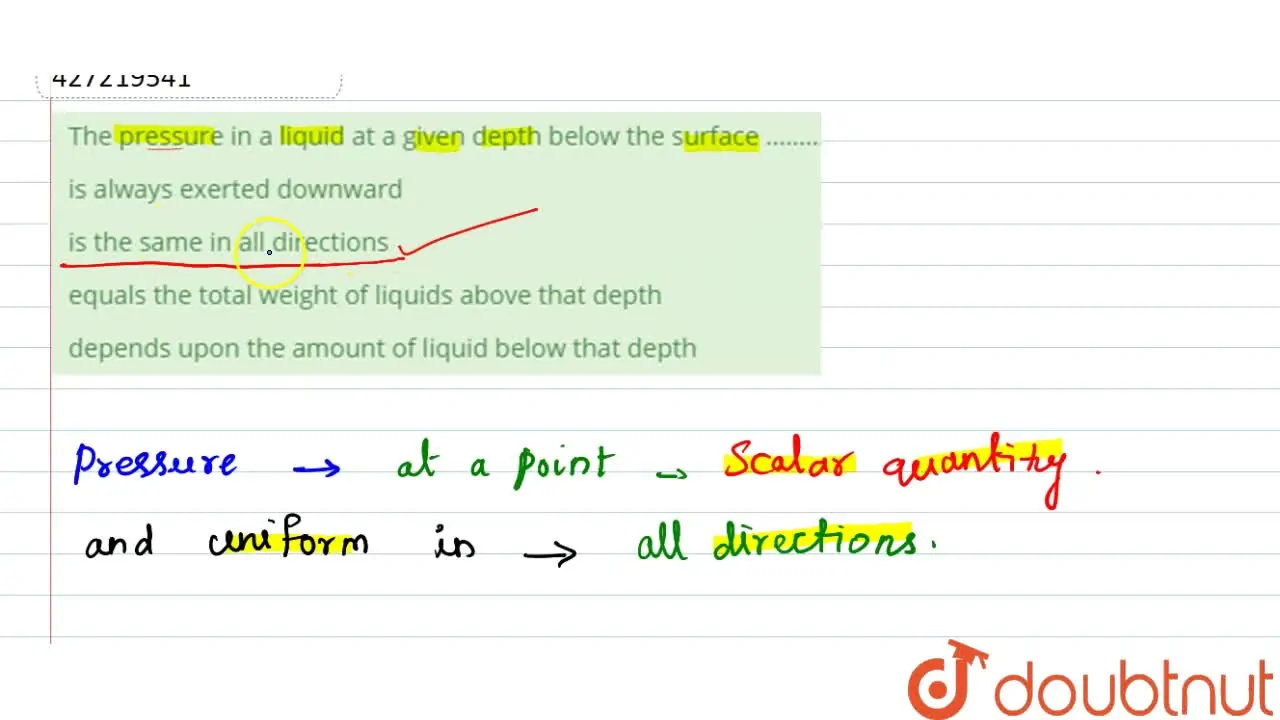The pressure in a liquid at a given depth below the surface ………….. .Solution in Tamil
In order to understand the increase in pressure with depth below the water surface, consider a water sample of cross sectional area in the form of a cylinder. Let h1andh2 be the depths from the air-water interface to level 1 and level 2 of the cylinder, respectively. Let F1 be the force acting downwards on level 1 and F2 be the force acting upwards on level 2, such that F1=P1AandF2=P2A. Let us assume the mass of the sample to be m and under equilibrium condition, the total upwards force (F2) is balanced by the total downward force (F1+mg), in other words, the gravitational force will act downward which is being exactly balanced by the difference between the force F2−F1.
F2−F1=mg=FG .....(1)
where m is the mass of the water available in the sample element. Let ρ be the density of the water then , the mass of water available in the sample element is
m=ρV=ρA(h2−h1)
V=A(h2−h1)

Hence, gravitational force, FG=ρA(h2−h1)g
On substituting the W value in equation (1) F2=F1+mg⇒P2A=P1A+ρA(h2−h1)g
Cencelling out A on both sides,
P2=P1+ρ(h2+h1)g ....(2)
If we choose the level 1 at the surface of the liquid (i.e., air water interface) and the level 2 at a depth .h. below the surface, then the value of atmospheric pressure (say Pa). In addition, the pressure (P2) at a depth becomes P. Substituting these values in equation, we get
P=Pa+ρgh .....(3)

which means, the pressure at a depth h is greater than the pressure on the surface of the liquid, where Pa is the atmospheric pressure which is equal to 1.013×105Pa.
If the atmospheric pressure is neglected or ignored then
P=ρgh .....(4)
for a given liquid, ρ is fixed and g is also constant, then pressure due to the fluid column is directly proportional to vertical distance or height of the fluid column. This implies, the height of the fluid column is more important to decides the pressure and not the cross sectional or base area or even the shape of the container.
Let us consider three vessels of different shapes A, B and C as shown in figure. These vessels are connected at the bottom by a horizontal pipe. When they are filled with a liquid (say water), it occupies the same level even though the vessels hold different amounts of water. It is true because the liquid at the bottom of each section of the vessel experiences the same pressure.

Related Playlists
- BOOK - FULL MARKSCHAPTER - PROPERTIES OF MATTEREXERCISE - Textual Evaluation Solved - Numerical Problems5videos
PROPERTIES OF MATTER
- BOOK - FULL MARKSCHAPTER - PROPERTIES OF MATTEREXERCISE - Textual Evaluation Solved - Conceptual Questions5videos
PROPERTIES OF MATTER
- BOOK - FULL MARKSCHAPTER - PROPERTIES OF MATTEREXERCISE - Textual Evaluation Solved - Short Answer Questions29videos
PROPERTIES OF MATTER
- BOOK - FULL MARKSCHAPTER - OSCILLATIONS EXERCISE - ADDITIONAL QUESTIONS SOLVED (IV NUMERICAL PROBLEMS )10videos
OSCILLATIONS
- BOOK - FULL MARKSCHAPTER - SAMPLE PAPER - 2EXERCISE - PART-IV10videos
SAMPLE PAPER - 2
Similar Questions
A cappilary of diameter d mm is dipped in water such that the water rises to a height of 30 mm. If the radius of the capillary is made (23) of its previous value, then compute the height up to which water will rise in the new capillary ?
06:08View SolutionWhy coffee runs up into a sugar lump (a small cube of sugar) when one corner of the sugar lump is held in the liquid?
01:39View SolutionDefine stress and strain.
02:30View SolutionA pendulum is hung from the roof of a sufficiently high building and is moving freely to and fro like a simple harmonic oscillator. The acceleration of the bob of the pendulum is 20ms−2 at a distance of 5 m from the mean position. To find the time period of oscillation.
03:20View SolutionExplain in detail the idea of weightlessness using lift as an example.
02:47View SolutionA beaker containing a liquid of density rho moves up with an acceleration a . The pressure due to the liquid at a depth h below the free surface of the liquid is.
03:34View SolutionThe pressure at depth h below the surface of a liquid of density ρ open to the atmosphere is
03:34View SolutionThe absolute pressure at a depth h below the surface of a liquid of density ρ is [Given Pa = atmospheric pressure, g = acceleration due to gravity]
View SolutionIf the atompspheric pressure is Pa then the jpressure P at depth a below the surface of a liquid of density ρ open to the atmosphere is
02:26View SolutionDerive an equation for the total pressure at a depth 'h' below the liquid surface.
01:22View SolutionHow does liquid pressure depend on the depth of a point below the surface of a liquid
03:24View SolutionHow does liquid pressure depend on the depth of a point below the surface of a liquid
01:43View SolutionDerive an expression for the total pressure at a depth 'h' below the liquid surface.
05:53View SolutionThe pressure in a liquid at a given depth below the surface ………….. .
01:14View SolutionThe pressure at depth h below the surface of a liquid of density rho open to the atmosphere is
01:35View Solution


